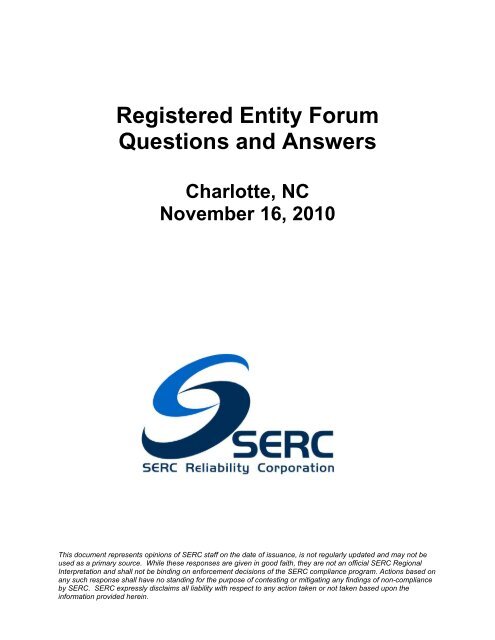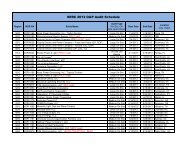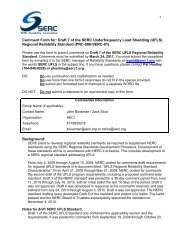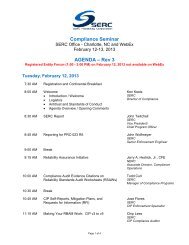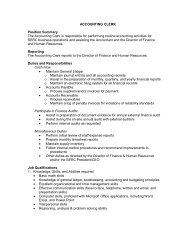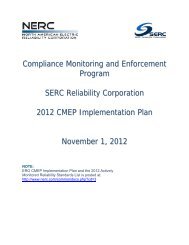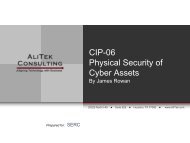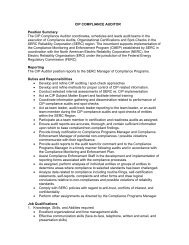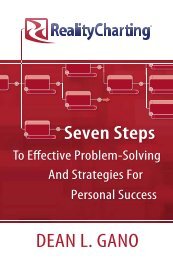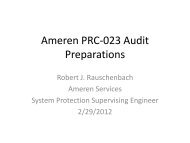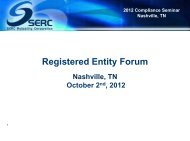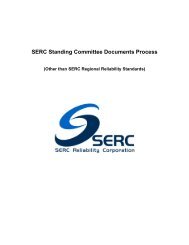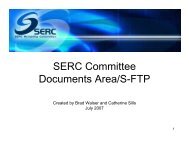REF Questions & Answers - Charlotte Seminar - SERC Home Page
REF Questions & Answers - Charlotte Seminar - SERC Home Page
REF Questions & Answers - Charlotte Seminar - SERC Home Page
You also want an ePaper? Increase the reach of your titles
YUMPU automatically turns print PDFs into web optimized ePapers that Google loves.
NOPRhttp://www.nerc.com/files/Supplemental-NOPR-TLR05162008.pdfFinal Orderhttp://www.nerc.com/files/Order_713_Modified-INT_and_TLR-Stds-07212008.pdfThe Interpretation, approved by FERC states:“New or replacement equipment that provides the same functions noted above, requires thesame calibrations. Some devices used for time error and frequency measurement cannot becalibrated as such. In this case, these devices should be cross-checked against other properlycalibrated equipment and replaced if the devices do not meet the required level of accuracy.”In addition, Requirement R8, and more specifically R8.1, is the only requirement that concernsredundancy:R8. The Balancing Authority shall ensure that data acquisition for and calculation of ACEoccur at least every six seconds.R8.1. Each Balancing Authority shall provide redundant and independent frequencymetering equipment that shall automatically activate upon detection of failure of theprimary source. This overall installation shall provide a minimum availability of 99.95%.<strong>SERC</strong> and the other Regions have agreed that the intent of this standard is to ensure thatdata is collected and ACE is calculated every six seconds and that the frequency monitoringequipment to perform that task is available 99.95% of a year. While it can be interpreted tosay that redundant equipment and auto swap features are required, the VSL table does notaddress the severity of a violation based on anything except the availability of equipment at arate of 99.95% per year. Because failure of the primary device my result in the loss offrequency monitoring for greater than six seconds and for greater than .05% of the year,entities may choose to meet this requirement using an automatic transfer to a redundantdevice. Once that redundant device is in service, it must meet the other requirementsincluding R17. Since entities will employ various methods to comply with these standards,<strong>SERC</strong> cannot identify components that would NOT be covered by any of the requirements.13. What happens during an emergency situation where public service personnel (i.e.,police, firemen) must take control of a facility, particularly a PSP, and safety issueswon’t allow for ingress/egress logging or escorting?In such an event, the Registered Entity should document the emergency situation that causedlogging or escorting to be discontinued, noting any interim measures employed to maintainsecurity of the PSP, and any subsequent follow-up conducted to ensure no breachesoccurred.<strong>Page</strong> 6 of 12
14. In a question related to NERC Facility Ratings Alert – on a NERC webinar for the Alert,NERC staff indicated that the Alert applied to all transmission, radial or otherwise, andmade no reference to the BES/BPS definition, despite the fact that the Alert only wentout to TOs. (DP/LSEs with radial 100/115/69-kV transmission would not have receivedthe Alert; but in theory, would still have to comply.)[Response provided by NERC staff]: NERC expects that all entities with transmission facilitiesreview the Alert and respond appropriately; identify their facilities, develop an assessmentplan, and develop action plans as necessary. Compliance guidance is provided in CAN-009:FAC-008 and FAC-009, found at:http://www.nerc.com/files/CAN-0009_FAC-008%20%20FAC-009.pdf15. BAL-005 requires various equipment to be “in the metered boundaries” of a BalancingAuthority Area. What is the best way to demonstrate compliance?There are several ways to demonstrate that an entity’s equipment is within the meteredboundaries of their Balancing Authority. Some of the types of evidence that have beenprovided are: Interconnection Agreements, Operating Agreements, facility diagrams withmetering source and output identified, letters of certification from BAs, etc.16. PRC-008 addresses UFLS, yet that term is not defined in the NERC glossary. Whatequipment or devices are included in UFLS? Is this defined by the Regions or is therea NERC/FERC definition?As stated above, the term UFLS is not defined in the NERC Glossary. FERC, in Order 693,Footnote 101 states:A UFLS program is a "safety net" that will automatically drop load at specificlocations in the power system in an effort to re-establish the balance betweengeneration and load to avoid cascading.PRC-008-0 – Underfrequency Load Shedding Equipment Maintenance Programs,Requirement 1 states:R1. The Transmission Owner and Distribution Provider with a UFLS program (asrequired by its Regional Reliability Organization) shall have an UFLSequipment maintenance and testing program in place. This UFLS equipmentmaintenance and testing program shall include UFLS equipmentidentification, the schedule for UFLS equipment testing, and the schedule forUFLS equipment maintenance.Identification of UFLS equipment is currently left to the discretion of the Registered Entity.<strong>Page</strong> 7 of 12
Also, <strong>SERC</strong> is developing a Regional Reliability Standard describing, in detail, therequirements for UFLS systems in the <strong>SERC</strong> Region. The current draft is posted at:http://www.serc1.org/Documents/<strong>SERC</strong>%20Standards%20Committee/<strong>SERC</strong>%20Draft%20Standards%20Posted%20for%20Pre-ballot%20Review/<strong>SERC</strong>%20UFLS%20Standard_Draft-8/<strong>SERC</strong>%20UFLS%20Std_PRC-006-<strong>SERC</strong>-01%20Draft-8%20(04-28-11)%20Clean.pdf17. PRC-008, many Registered Entities currently use modern recloser controls to provideunder frequency protection/load shedding. However, there exists no procedure or testequipment for testing this underfrequency (UFLS) function in recloser controls. Does<strong>SERC</strong>/NERC accept a test of the recloser control’s overall operation (trip/close) asmeeting the testing requirement of UFLS equipment?An entity relying on recloser controls to provide UFLS protection must be able to demonstratethat the device is tested and maintained in such a manner that verification of tripping at thedesired frequency set-point and time delay is consistently achieved. Additionally, the entitymust be able to demonstrate that operation of the device sheds the correct percentage ofload, as specified by the Planning Coordinator.For additional information, please reference FERC Interpretation of Protection SystemReliability Standard – Docket No. RM10-5-000 dated December 16, 2010.18. If an entity is covered by a Joint Registration Organization (JRO), how will an auditcover the requirements assigned to the other party? For instance, will the audit teamskip the item? Or, will the audit team expect an explanation? (NERC white paper/CAN)In accordance with the NERC Rules of Procedure, in a JRO, one entity assumes allcompliance responsibility for another entity (or entities) and would be the only entity subject toan audit. If, on the other hand, with a Coordinated Functional Registration (CFR), where twoor more entities split compliance responsibilities, there would be more than one audit, each ofwhich would cover only the standards and requirements applicable to the entity, as listed inthe CFR. (i.e., Per the CFR, Company A is responsible for R1, R2, and R3, and Company Bis responsible for R4 and R5; so only R4 and R5 will be reviewed at the time of Company B’saudit.)It should be noted that there is a simple process to go through to create a JRO or CFR, butpaperwork does need to be filled out, routed through <strong>SERC</strong>, and officially recognized byNERC to be valid. For related information regarding responsibilities and third parties, pleasereference NERC Compliance Public Bulletin #2010-004 dated April 6, 2010.<strong>Page</strong> 8 of 12
19. The draft CIP-002-4 R1.1 references a “group of generating units at a single plantlocation”. Can <strong>SERC</strong>/NERC provide a definition of what is meant by the term “singleplant location”? (R1.8 also references a “single station location” – same questionhere.)CIP-002-4 has been approved by the NERC Board of Trustees. and has been filed with theCommission for approval. Please see the reference document developed in conjunction withthe standard for discussion of the rationale for, and meaning of, the criteria in Appendix A tothe Reliability Standard:http://www.nerc.com/docs/standards/sar/Project_2008-06_CIP-002-4_Guidance_clean_20101220.pdfIn addition, the CIP Version 4 drafting team conducted a technical webinar on September 29,2010 that covered some of the details around CIP-002-4 Attachment 1. The link to arecorded stream and the slides from the webinar can be accessed here:http://www.nerc.com/page.php?cid=1|8320. FERC Order 733, Section 342: “Therefore, no generator owner that is not also atransmission owner and/or a distribution provider will be subject to PRC-023-1.” Canthis statement be added to PRC-023-2 within the Applicability section of the standardfor clarity?<strong>SERC</strong> will pass this suggestion along to NERC Standards Group. As a reminder, RegisteredEntities have the opportunity to comment on any proposed new or revised ReliabilityStandard, including those that arise out of directives issued by the Commission21. During a NUC-001 audit, what specific things will <strong>SERC</strong> look for to demonstratecompliance with this standard? (Obviously a NPIR contract/document, but what else?)How does <strong>SERC</strong> interpret terms in NUC-001 that have not been defined in the NERCglossary? For example, “applicable transmission entity”.Auditors will require evidence that confirms: what NPIRs the Nuclear Plant GeneratorOperator was required to issue; verification that the required NPIRs were delivered to theapplicable “Transmission Entity”; verification of receipt of the NPIR by the applicable“Transmission Entity; evidence that the Nuclear Plant GOP and applicable “TransmissionEntity” have mutually agreed upon agreements to meet the requirements, policies andprocedures in place to ensure adherence to said agreements by both parties; verification ofimplementation of the agreed upon policies and procedures; etc.Applicable Transmission Entity is a registered entity that has been issued a NPIR by theNuclear Plant Generator Operator.For additional information, please reference FERC Order 716 - Mandatory Reliability Standardfor Nuclear Plant Interface Coordination.<strong>Page</strong> 9 of 12
22. As a BA, I am required to own and maintain UFLS equipment. Why am I required toregister as a DP or LSE?Entities are registered in accordance with the criteria specified in the NERC Rules ofProcedure and the Statement of Compliance Registry Criteria (currently Revision 5.0). While aBA is a “responsible entity that integrates resource plans ahead of time, maintains loadinterchange-generationbalance within a BA area, and supports Interconnection frequency inreal time” and must have the capability to shed load to restore balance between generationand load, the responsible entity for owning and maintaining UFLS equipment is a TO or DP.The responsible entity for operating UFLS equipment is a TOP or LSE. Therefore, entitieswho own, operate or maintain UFLS equipment must be registered as a TOP and/or LSE andas a TO and/or DP, in accordance with the criteria. This ensures that no gap exists inreliability responsibility for UFLS devices.23. In VAR-002 R1, the GOP is required to operate with Automatic Voltage Regulator (AVR)in ‘service’ and in ‘auto’ unless the GOP has notified the TOP. What is <strong>SERC</strong>’s positionon standing notifications (i.e., one-time notification) for units without AVRs and/or unitsthat normally start up in manual and shut down in manual AVR?If an entity can provide evidence of a written notification that has been acknowledged andagreed upon by both parties (GOP and TOP) that the entity does not have AVR or that theunits are normally started and shut down with the AVR in manual, such evidence may beacceptable. The entity and TOP may want to consider, at a minimum, annual review of thisnotification and acknowledgement that the conditions still exist and such treatment isacceptable to both parties.24. Does <strong>SERC</strong> find that companies are filing TFEs in relation to remote access devicesthat are CCAs (i.e., laptop computers) where a “six-wall” perimeter cannot always beestablished? (Relates to CIP-006, R1.1.)No, we are not aware of any CIP-006 TFEs being submitted within <strong>SERC</strong> to cover remoteaccess CCAs at this time.25. All Regional Entities, including <strong>SERC</strong>, are experiencing significant backlogs inaudit/spot check “throughput” to resolution. Gerry Cauley has mentioned, during acouple of meetings, that it might be time to “wipe the slate clean and start over”. Is<strong>SERC</strong> pursuing with NERC permission for the possibility of suspending audits/spotchecks until they can clear their backlog?There is no initiative underway to suspend compliance monitoring activities or to provide foranother “amnesty period” similar to the opportunity provided during the period immediatelyprior to June 18, 2007. NERC and the Regions have implemented a new “AdministrativeCitation Process” beginning in January 2011 to provide for a more streamlined mechanism for<strong>Page</strong> 10 of 12
processing minor violations of the Reliability Standards. The risk-based, performance-basedcompliance monitoring approach discussed in the 2011 CMEP Annual Implementation Planrepresents an additional effort to prioritize compliance activities and more effectively managethe workload.26. Regarding the Aurora process, the documents (NERC documents on <strong>SERC</strong> website)“Pre-assessment Facility Checklist” describes under purpose, “facility managers” and“operators” of utility facilities. Would <strong>SERC</strong> please provide definitions for thesepositions and for utility facilities?<strong>SERC</strong> cannot provide the requested definitions. NERC has listed a point of contact forquestions regarding the Aurora process, and entities should reach out to NERC for necessaryclarifications.27. RE: Aurora, on the “Quick-Look Checklist”, question 1 asks if a facility containssusceptible equipment. Some utilities have large medium voltage pump motors whichwould/could be impacted by an Aurora event. But, question 2 asks, “Is it connected tothe grid?” If the answer is “no”, it says to quit the assessment. What doesNERC/<strong>SERC</strong> expect utilities to do? Please define “the grid”. Is it the transmissiongrid? Checklist item 3 uses the term “commercial power grid”. Is that the BES or alower voltage grid such as a distribution system?<strong>SERC</strong> cannot provide guidance on this request. NERC has listed a point of contact forquestions regarding the Aurora process, and entities should reach out to NERC for necessaryclarifications.28. With respect to the Aurora questions, how do you handle utility intentionalinstantaneous reclosers?<strong>SERC</strong> cannot provide guidance on this request. NERC has listed a point of contact forquestions regarding the Aurora process, and entities should reach out to NERC for necessaryclarifications.29. For EOP-004, are distribution system outages caused by natural disasters that exceed50% of a utility’s total customers reportable?A Registered Entity is expected to follow the reporting criteria established in EOP-004. EOP-004 states that reports are to be made for “[e]quipment failures/system operational activitieswhich result in the loss of firm system demand for more than 15 minutes…for all such lossesof firm demands totaling more than 200 MW or 50% of the total customers being suppliedimmediately prior to the incident, whichever is less.” While EOP-004 does not specifically<strong>Page</strong> 11 of 12
address “distribution system outages caused by natural disasters”, if an event meets thecriteria, a report should be made.It should be noted that changes may occur in the future based on the development of EOP-004-2. Please see Project 2009-01 on the NERC website for additional information.Also, please see <strong>SERC</strong> Implementation Guidance Request No. 09-001 (09-02-10) posted at:http://www.serc1.org/Documents/Formal%20Interpretation%20Implementation%20Guidance/Submitted%20Requests/2009%20Requests/<strong>SERC</strong>%20Implementation%20Guidance%20Request%20No%2009-001%20(09-02-10).pdf30. With respect to CIP-005, R2.4, can <strong>SERC</strong> provide its interpretation of what constitutes“external interactive access”? Could <strong>SERC</strong> also provide guidance for compliance withCIP-005 R2.5.3 with respect to its interpretation?“External interactive access” is access into the ESP which could allow a user or process toaccess or interact with a Cyber Asset. There are a number of NERC initiatives around remoteinteractive access which may provide further guidance, including Compliance ApplicationNotice (CAN)-0005, the proposals around Urgent Action revisions to CIP-005-4 (in draft), andthe associated guidance document (in draft).31. Are there plans underway (a new ruling) to NERC CIP standards to address allowing aprescribed outage time (24, 48, or 72 hours, etc.) to perform scheduled maintenance(reboots, trouble shooting, etc. ) on applicable software, hardware, application, anddevices, etc? For example, CIP-007 R6, Security Status Monitoring, if the deviceperforming the monitoring function needs maintenance, is it required to self-report orsubmit a TFE for the period that monitoring is not being performed?This issue has been identified as one needing clarification and is being considered as a futureCAN (line 23 of the September 13, 2010 version of NERC Identified CANs matrix:http://www.nerc.com/page.php?cid=3|22|354)32. How does the Portal handle the prior <strong>REF</strong> Q&A posted from previous complianceseminars?The <strong>REF</strong> <strong>Questions</strong> and <strong>Answers</strong> from each of the 2010 compliance seminars are posted onthe <strong>SERC</strong> public website under the Compliance tab, 2010 Program – Outreach.<strong>Page</strong> 12 of 12


